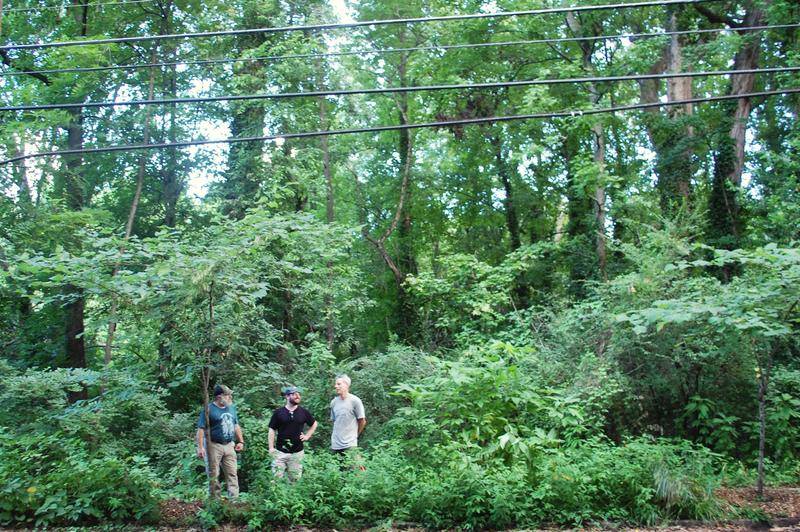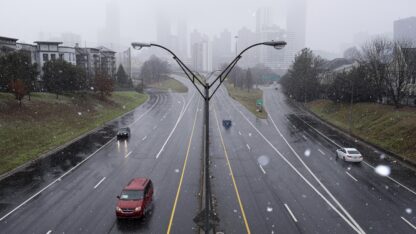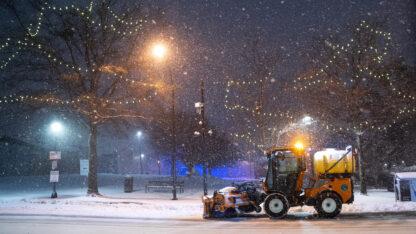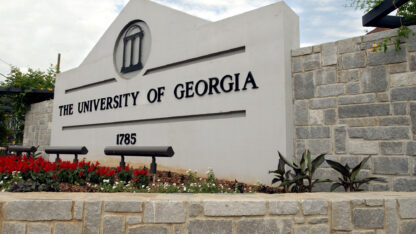Atlanta Decides Which Urban Forests Are Worth Buying

Atlanta has a new tool to help preserve its tree canopy. A change in law late last year allowed the city to start using fees from developers to buy and protect private green space.
But the question now is, which forests deserve the money?
The Value In A Forest
To get a view of the Ormewood Forest in East Atlanta, a small group of neighbors head through a backyard to a chain link fence. There, at the forest’s border, a cloud of mosquitos rises up.
Alex Levy points to the English Ivy on the ground.
“Every one of those leaves is like a beach umbrella for a sun-stroked mosquito,” Levy says. “They’re loving it.”
Beyond the fence are 6 acres of private property, much of it undeveloped forest. It’s filled with invasive species, like ivy, making the space dense and overgrown.
But the neighbors here want to protect it. Grant Dollar says these woods, while not the healthiest, are still special.
“My back deck looks right over a lot of the old oak trees that take up Ormewood Forest,” Dollar says. “And this time of the year in the summer it’s the birds of the forest that wake me up in the morning before my alarm clock.”
Standing next to Dollar, Levy agrees.
“We’re only three miles from downtown and have a pocket of forest, where on some days you could probably find wild turkey and even white-tailed deer,” Levy says. “There’s a lot of value here, even though there’s a lot of weeds growing in the garden.”
There’s enough value, the neighbors say, to make this more than a million dollar property worth buying.
And the city can do that now, using money in the Tree Trust – a fund developers pay into when they cut down trees and don’t replant them. It’s currently collected $7 million.
But what if other forests in Atlanta are a better deal?
Bang For The Buck
“I think if you’re going to try to protect intact canopy inside the city, you first have to go for the larger forests. You’re going to get more bang for your buck,” says Stacy Funderburke of the Conservation Fund, who is helping the city identify greenspaces to acquire.
As an example of the kind of forests he thinks Atlanta should protect, Funderburke points to the Cascade Springs Nature Preserve. Inside the 120 acres along Cascade Road, the forest floor is open and the thick tree cover provides complete shade.
“A forest like this can take 100 years to get to this point,” Funderburke says. “And that means that a lot of the native species are here, the canopy is intact, these large trees, the water protection that those provide.”
A less disturbed forest holds a lot of important environmental benefits, he says. And while this one, Cascade Springs, is already public land, there are similar greenspaces in Atlanta that aren’t.
“If I was thinking about justifying this use of tree recompense funds, I would want to show especially on the front end that we’ve protected some of the largest, intact, oldest growth forest inside the city,” he says.
The fact is, those large forests cost less too, he says, because they’re located in south and southwest Atlanta, where land is cheaper.
Weighing The Costs
Other cities have used impact fees to purchase forests and faced this decision between expensive urban trees and lower cost ones that are more remote. Charlotte, for example, opted for the latter and the city was able to acquire 200 acres for the price of about $2 million.
In Atlanta, the city is compiling a list of properties to purchase right now, according to planning commissioner Tim Keane. And one of the factors it is looking at is cost – that bang for the buck.
“But I will say even smaller properties warrant consideration,” he says, “because in some of the more urban parts of the city what might be considered a relatively small forest could play a very important role in terms of wildlife and just quality of life.”
U.S. Forest Service researcher David Nowak, who has worked to quantify the benefits of trees, says the return on forests can be greatest when they’re in closest to the most people.
Trees remove air pollution and, in the process, improve people’s health. Nowak says they do most of that work in urban areas.
“You can buy cheap land out in rural lands, but the impact to the core of people in downtown Atlanta will be minimal because the trees are so far away,” he says.
Investing In Atlanta’s Canopy
The future of the small, urban Ormewood Forest may be decided soon. A developer is now working to rezone the property to build cottage style homes.
The proposal would preserve some of the greenspace. But standing at the chain link fence border, the East Atlanta residents says the forest should be preserved entirely.
The trees inside it help make up the canopy Atlanta is known for, they says.
“I really think looking at dollars what the neighborhood has to lose – what the city has to lose – in value,” neighbor Bill Gould says, “is much greater by letting it go than by investing a million dollars or whatever it takes to get it.”








